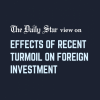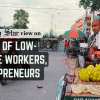Shocks and shields: Economic resilience during turbulent times

The economic turbulence that Bangladesh is going through right now is rooted in massive global supply-side shocks. With the Russia-Ukraine war and the resultant global supply chain disruption in hindsight, there are uncertainties about how long these shocks will persist. However, there are three sets of problems that actually emerged out of the supply-side shocks: a) a macroeconomic crisis entailing a long list of issues, the most pressing among which are a falling growth rate, obstructed recovery from the pandemic, inflationary pressure, balance of payment, and debt burden; b) social impacts ensuing partly from the elongated pandemic impacts, including poverty and inequality; and c) problems in achieving larger development goals such as gender equality and various other issues related to the SDGs.
Among these issues, the effects of the macroeconomic crisis are visible, thanks to the quality data and impact analyses, and we can track down what is happening in this area. However, remarkably, the same cannot be said about the social impacts or the impacts on larger development goals, perhaps because of the lack of regular surveys and updates in the respective areas and the inadequacies in the existing ones.
Whether these problems will leave mild or debilitating impacts depends on our economic resilience. There are three aspects of economic resilience: a) the ability to recover quickly from a shock; b) the ability to withstand a shock; and c) the ability to avoid the shock altogether. We talk plenty about the first two aspects, but less about the last one, because there is hardly any way to avoid such shocks.
How do we build economic resilience? There are four crucial areas to consider for that: a) broad-based economic growth; b) macroeconomic management, including revenue mobilisation, budget deficit, financial sector, balance of payment, etc; c) strengthening the social sector, especially health and education; and d) strengthening institutions.
Bangladesh's economic growth performance has been encouraging, but questions remain regarding the drivers and quality of said growth in terms of reducing poverty and inequality and promoting employment. RMG exports and remittances have been our major growth drivers for a long time, with no major efforts to seek alternatives, and poverty, inequality and lack of employment in the midst of strong growth stories still being major concerns. The challenges in these areas have intensified during the ongoing crisis.
We need to undertake important reforms, especially in major areas such as taxation, financial sector, budget management, export diversification, trade policy, healthcare, education, social safety net, labour market, etc. Interestingly, there is a consensus on the need for these reforms – the sixth, seventh, and eighth five-year plans of the government have highlighted many discussions on these reforms. But little progress has been achieved regarding the reforms. The reasons for that may involve confusion regarding the objectives and results of the reforms, strong resistance from some vested interest groups who may be hurt by the reforms, and a lack of understanding on the adjustment costs of reforms. Another less-talked-about but important reason is the misalignment of actors in terms of influence and interest.
But we cannot continue to be completely dependent on RMG exports and remittances for growth as our economy will eventually shift to a different structure in the future. Specialised Economic Zones (SEZ) and mega-infrastructure projects can be possible sources of major growth in terms of attracting investments – both domestic and foreign. However, the challenges of implementing these projects on time and in a cost-effective manner must be duly addressed. Diversification of economic and export structures is obligatory and there is a need for broad-based industrial policies in this regard.
Until the onset of the current crisis, Bangladesh was successful in terms of managing budget deficit, current account deficit, inflationary pressure, exchange rate stability, and growing foreign exchange reserves. But despite these macroeconomic successes, the country is facing several long-standing issues, the most pressing of which are a very low tax-GDP ratio, a high degree of non-performing loans (NPLs) and weak governance in the banking sector, low foreign direct investment (FDI), misalignment of exchange rate hurting export promotion and export diversification, large amount of illicit outward money transfer, a high amount of subsidies in the annual budget, and inefficiency in budget implementation.
In the social sector, there has been significant improvement in reducing child and maternal mortality rates, increasing life expectancy, gross school enrolment, and gender parity in primary education. However, the quality of education and healthcare is questionable. The policy paralysis related to public spending for education and health sectors remains a major issue, with the country having very low allocations in these sectors over the last two decades.
Poverty, inequality, and lack of employment became even more challenging after the pandemic broke out. Surveys conducted by Sanem at that time found a spike in the poverty rate and labour market distortion. Though there have been some recoveries, there are concerns that the ongoing macroeconomic crises may have made the situation worse.
Properly functioning institutions are also critically important for economic resilience. However, Bangladesh has had the long-standing problem of weak formal institutions as a result of ineffective bureaucracy and regulatory quality, little progress in transparency and accountability, lack of control of corruption, and weak enforcement of the rule of law. In the absence of well-functioning formal institutions, informal institutions take the lead, which undermines economic resilience.
To overcome that, we need to undertake important reforms, especially in major areas such as taxation, financial sector, budget management, export diversification, trade policy, healthcare, education, social safety net, labour market, etc. Interestingly, there is a consensus on the need for these reforms – the sixth, seventh, and eighth five-year plans of the government have highlighted many discussions on these reforms.
But little progress has been achieved regarding the reforms. The reasons for that may involve confusion regarding the objectives and results of the reforms, strong resistance from some vested interest groups who may be hurt by the reforms, and a lack of understanding on the adjustment costs of reforms. Another less-talked-about but important reason is the misalignment of actors in terms of influence and interest. For example, there are actors who are highly interested in reforms, but have little influence to get the ball rolling. And there are those who have high influence but little interest in reforms. There is also a strong incentive to maintain the status quo where the generation of rents from the existing system and distribution of such rents among the influential actors perpetuates the so-called "stable anti-reform coalition."
Looking at the power-interplay matrix of these actors, it is obvious that the existing highly influential actors have little incentives to break the status quo. Only strong political will for reforms can bring about some lasting changes to improve our economic resilience.
Dr Selim Raihan is professor at the Department of Economics of the University of Dhaka, and executive director at the South Asian Network on Economic Modeling (Sanem).

 For all latest news, follow The Daily Star's Google News channel.
For all latest news, follow The Daily Star's Google News channel. 











Comments